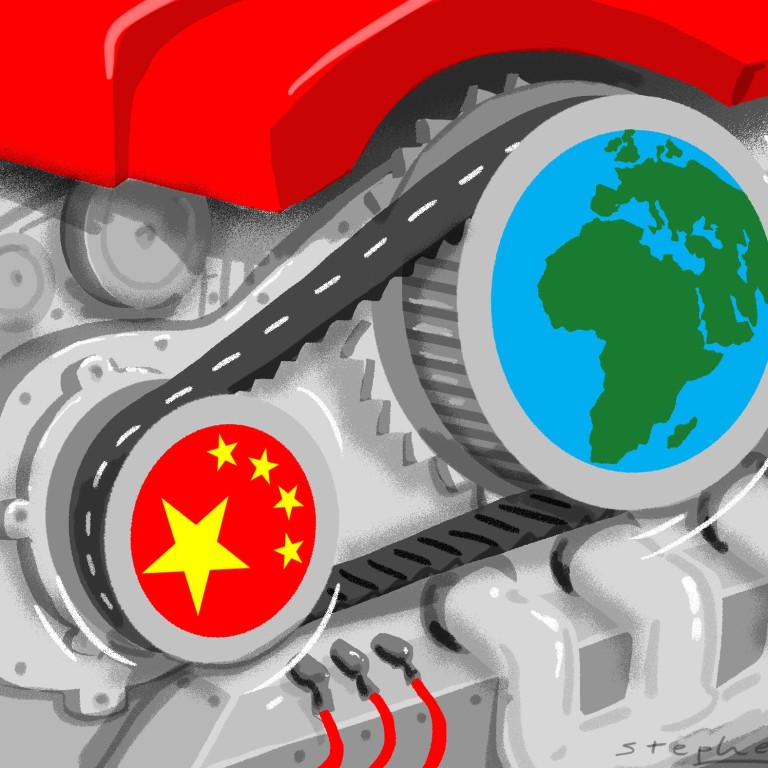
China’s belt and road strategy offers a winning growth formula, and the world must get on board
Liew Mun Leong says hurdles along the way are expected, but any doubts about China’s capacity to implement its ambitious strategy are dispelled when one considers its demonstrated capacity to turn large-scale dreams into reality at home
Last September, I had said that, given the then pessimistic world economy, there were only two major stimuli or drivers that could possibly reignite global growth: the Trans-Pacific Partnership (TPP) and China’s “Belt and Road” programme. The TPP is now as good as dead, and we are now left with the Belt and Road Initiative as the only global collaborative vision that could potentially be the engine of world economic growth.
Watch: Xi Jinping hosts the belt and road forum in Beijing
So does China have the capability to deliver on this grand plan? Over the past few decades, China has convincingly demonstrated its capability to deliver large-scale projects. I first visited China in 1982: it was then mired in abject poverty. Now it is the world’s second-largest economy. No one could have forecast its dramatic transformation.
I have been travelling to China regularly over the past 20 years, dealing with real estate business in various cities. Initially, I was less than sanguine about the mammoth projects China chose to embark on.
In the last 20 to 25 years, China has succeeded in delivering several gigantic transformational infrastructure projects. This includes Shanghai’s Pudong district, which has gone from being full of paddy fields to one of the world’s most vibrant financial centres; the Three Gorges Dam; and more than 20,000 kilometres of railway, including the Qinghai-Tibet high altitude line.
I have learnt not to underestimate China and to not doubt its proclaimed ambitious plans.
Xi Jinping announces new district in Hebei backwater to rival Shenzhen and Pudong
Of course, these were largely domestic projects and I am mindful that cross-border undertakings, such as the belt and road, will pose dramatically different challenges. Such a massive undertaking will certainly face a myriad of uncertainties caused by political, financial, technical, environmental and social, or other collaboration issues.
With rising protectionist sentiments in the US and EU, world growth and global trade are crucial. Jobs are a key problem in all these economies, especially in the EU and among the lower middle class in the US. The belt and road strategy has the potential to create growth, demand and jobs, and can therefore help to dampen protectionist sentiment globally.
For developing regions, growth is even more crucial. Most emerging economies like the countries in Southeast Asia, and in Central and South Asia, are facing what is called the “youth demographic bulge”, caused by a rising number of young people. Joblessness will be highly destabilising for them. Any global impetus and initiative to foster economic growth and create jobs in these regions can only be a positive.

Why Malaysia supports China’s belt and road
It is true that belt and road will increase China’s dominance and influence: that is inevitable
From an economic standpoint, many companies in the developed economies, such as the United States, European Union and Japan, can also benefit from the belt and road plan. China and the host countries will certainly need to tap into global industries and service providers from developed countries in the whole value-added chain, ranging from master planning, design, architectural services, consulting and project management, to legal and financial services. The knock-on effects of belt and road and the potential benefits to industry players from the developed countries cannot be denied.
As part of the belt and road fraternity and with increasing growth and development, today’s developing countries in the Association of Southeast Asian Nations, Central Asia and central Europe can develop, industrialise and urbanise. As the income in these regions increases and middle class expands, they can become future markets for developed countries.
It is true that belt and road will increase China’s dominance and influence: that is inevitable. Whether that is positive or negative is a subjective point, and different countries will have different geopolitical considerations.
However, China’s dominance and influence in world trade is already being felt worldwide, with or without the belt and road.
China realises that the plan must be open and inclusive to succeed. They should also surely be aware that such a plan cannot succeed without the cooperation of the host countries and the support of other developed countries.
Countries not directly involved can benefit by participating in the implementation and so partake in growth opportunities
For the host countries, the potential direct and indirect benefits of the initiative will likely outweigh any concerns of China’s global dominance – political or otherwise. I foresee that pragmatism will prevail and they will embrace the strategy for its economic benefits. As for countries that are not directly involved, they can still benefit by participating in the implementation process and so partake in the growth opportunities.
Non-participation and non-engagement, in my view, is not an option.
The world now lacks a key growth engine. I see the belt and road plan as the main locomotive for the global economy over the next decade. This is a plan designed for global infrastructure development to improve the connection between Asia and Europe.
Having a plan or vision is better than having none. Trying to make it work is better than speculating over whether it will work or not. Emerging countries, with their limited resources, may not have the means to find the means to seek their own vision for global expansion.
Xi Jinping’s ‘One Belt, One Road’ strategy is showing the way to a new world order
However, with all its capabilities and experience, China cannot fully deliver the plan without the participation and collaboration of all host countries. It will also need support in services and expertise from developed nations. If all parties concerned do get on board and work with China, the implementation of the belt and road plan is likely to transform the world economic landscape for the better. It will result in a “win-win-win” situation for China, and developing as well as developed countries.
Liew Mun Leong is chairman of both the Surbana Jurong Group and the Changi Airport Group based in Singapore. This is an edited excerpt of his speech at the “Global Infrastructure Initiative 2017” forum in Singapore on May 25, organised by McKinsey and Company



